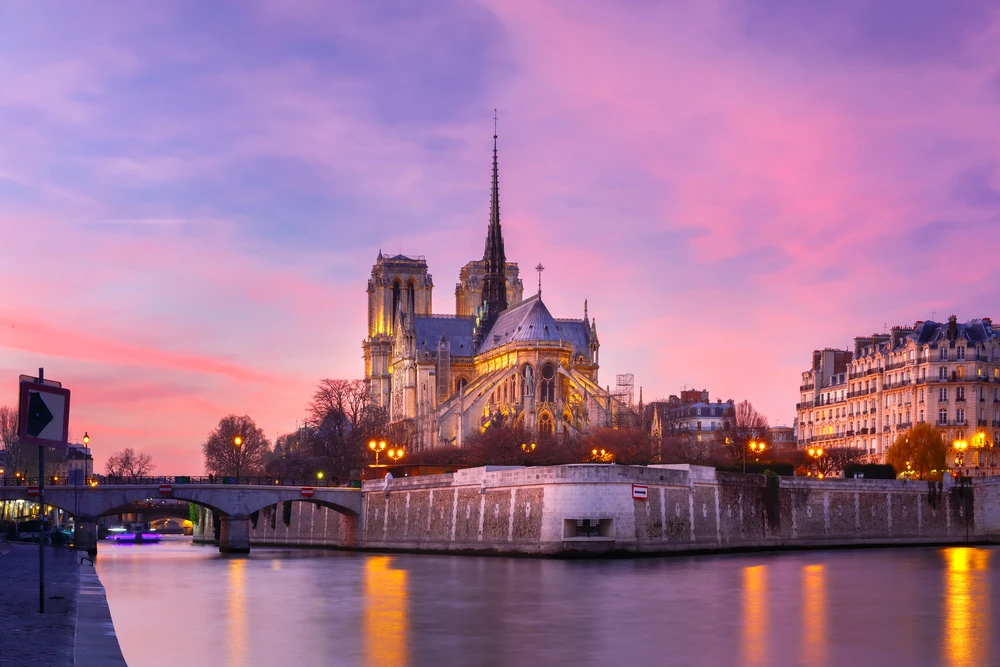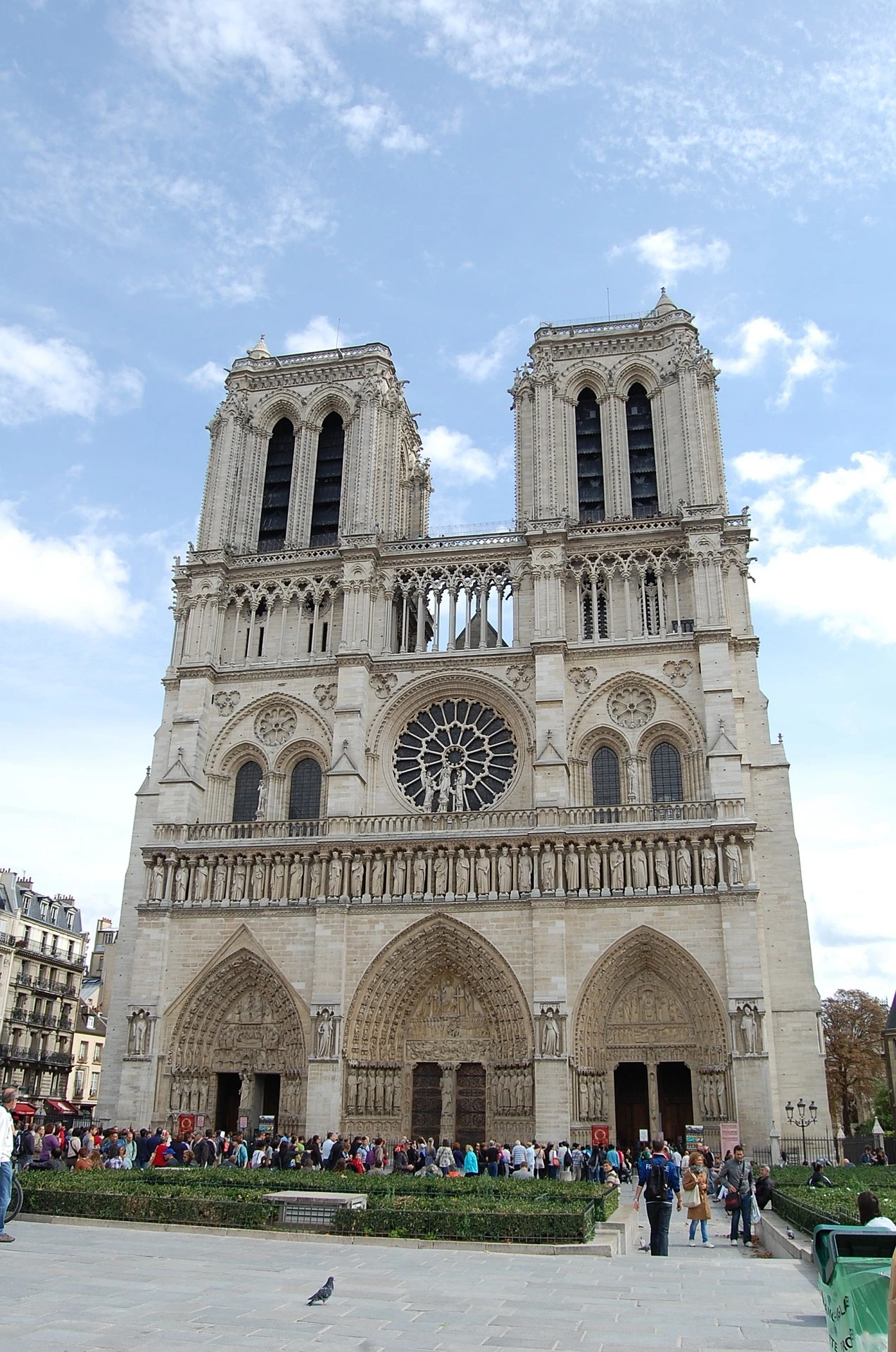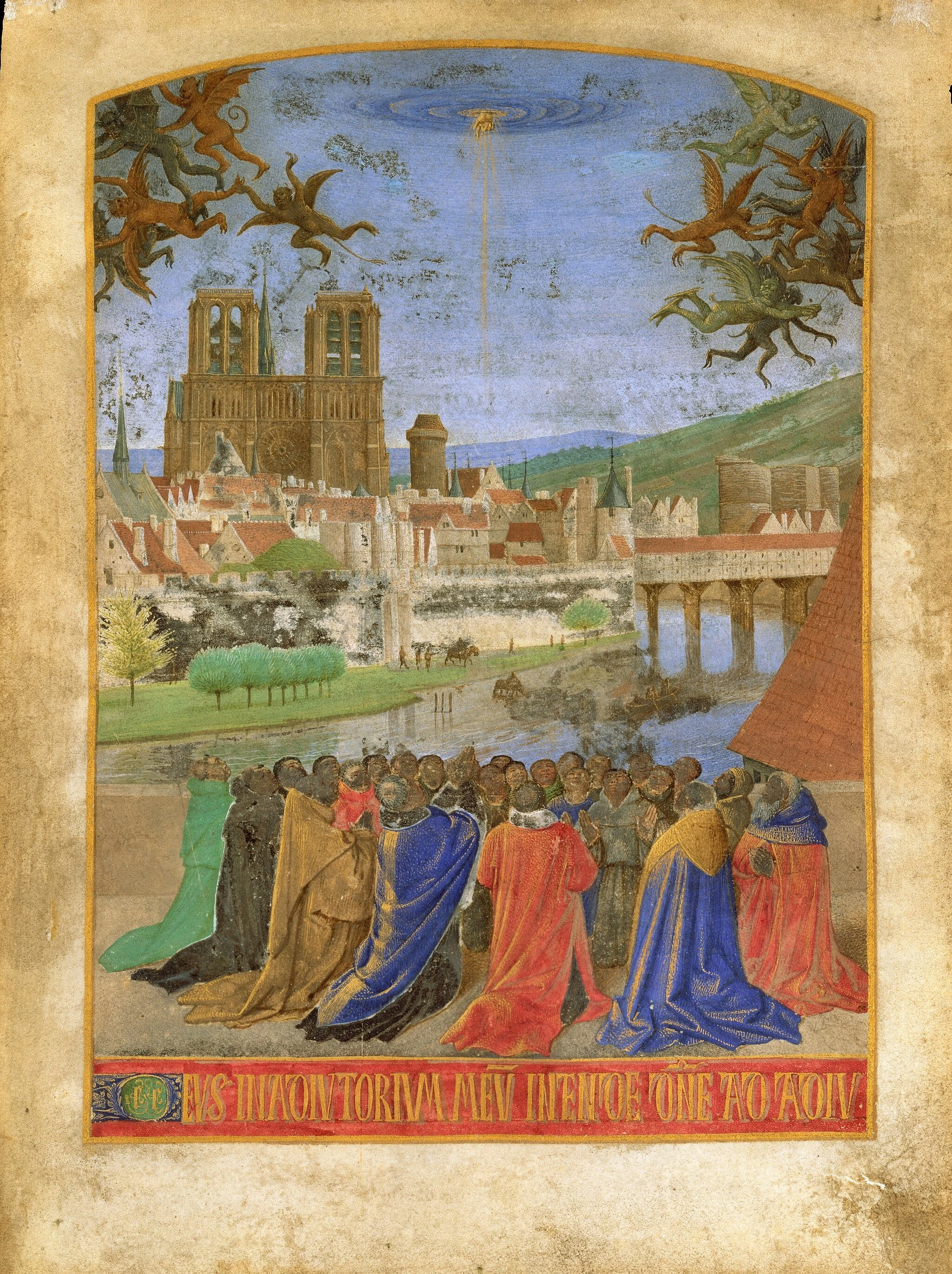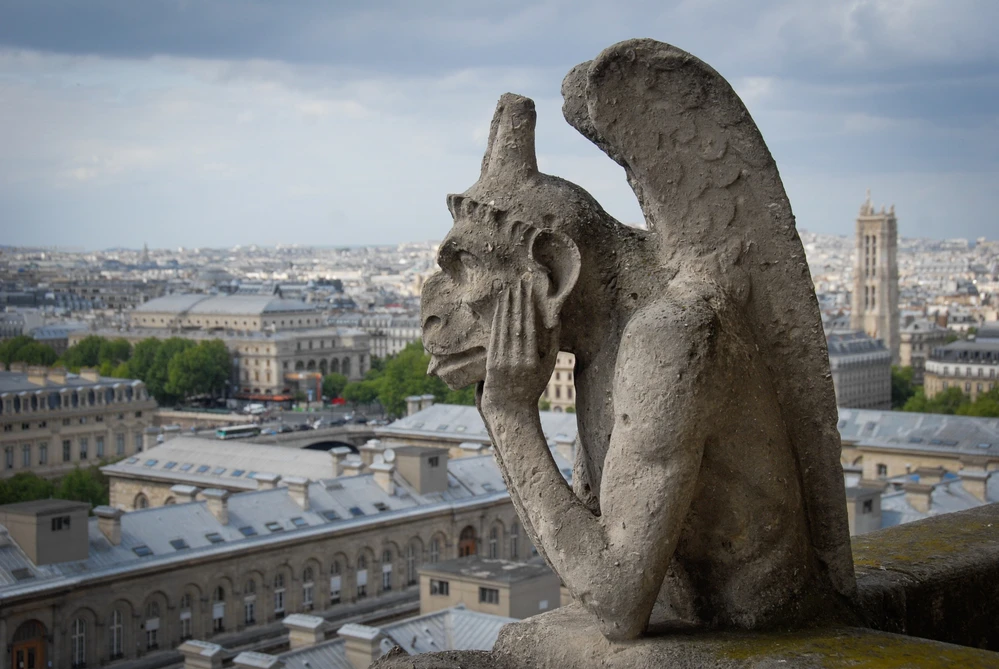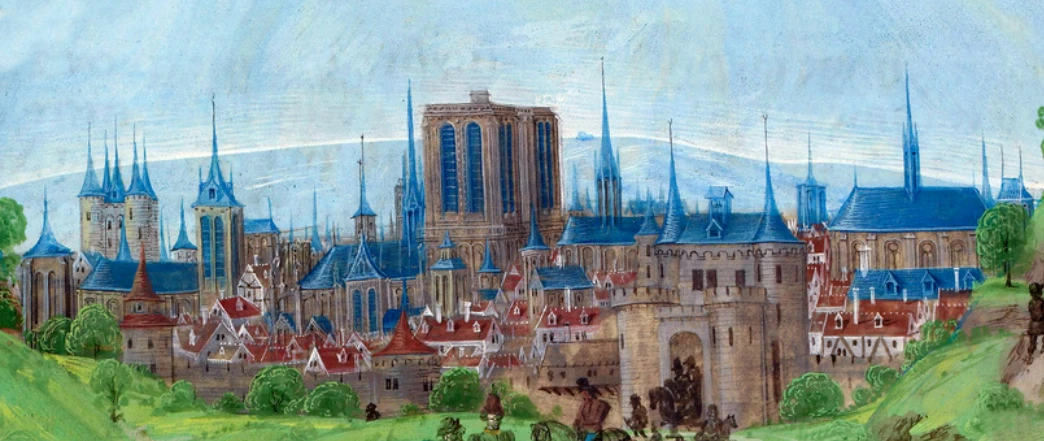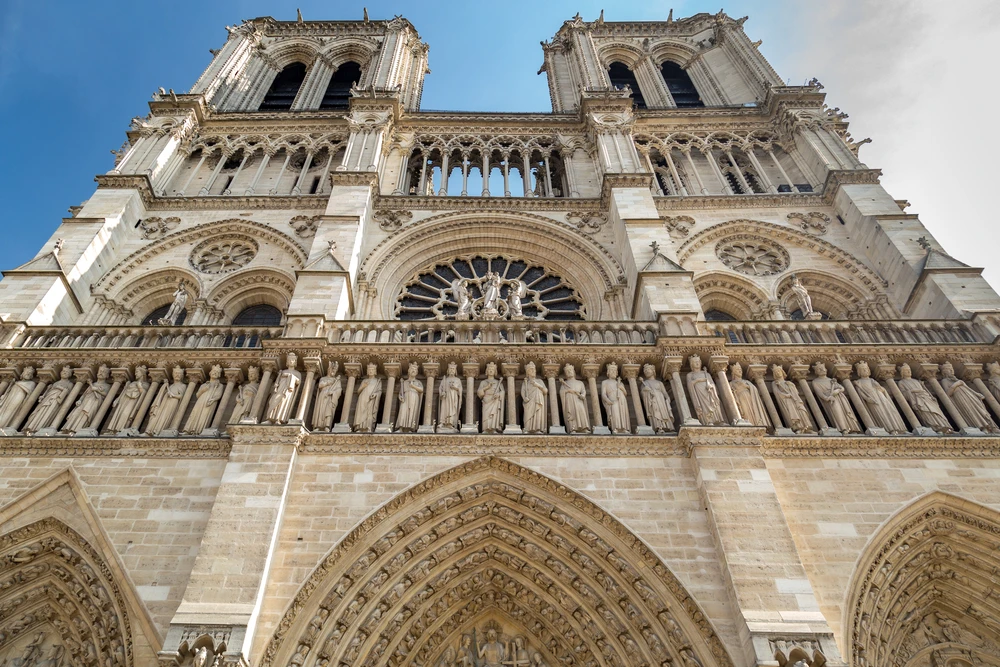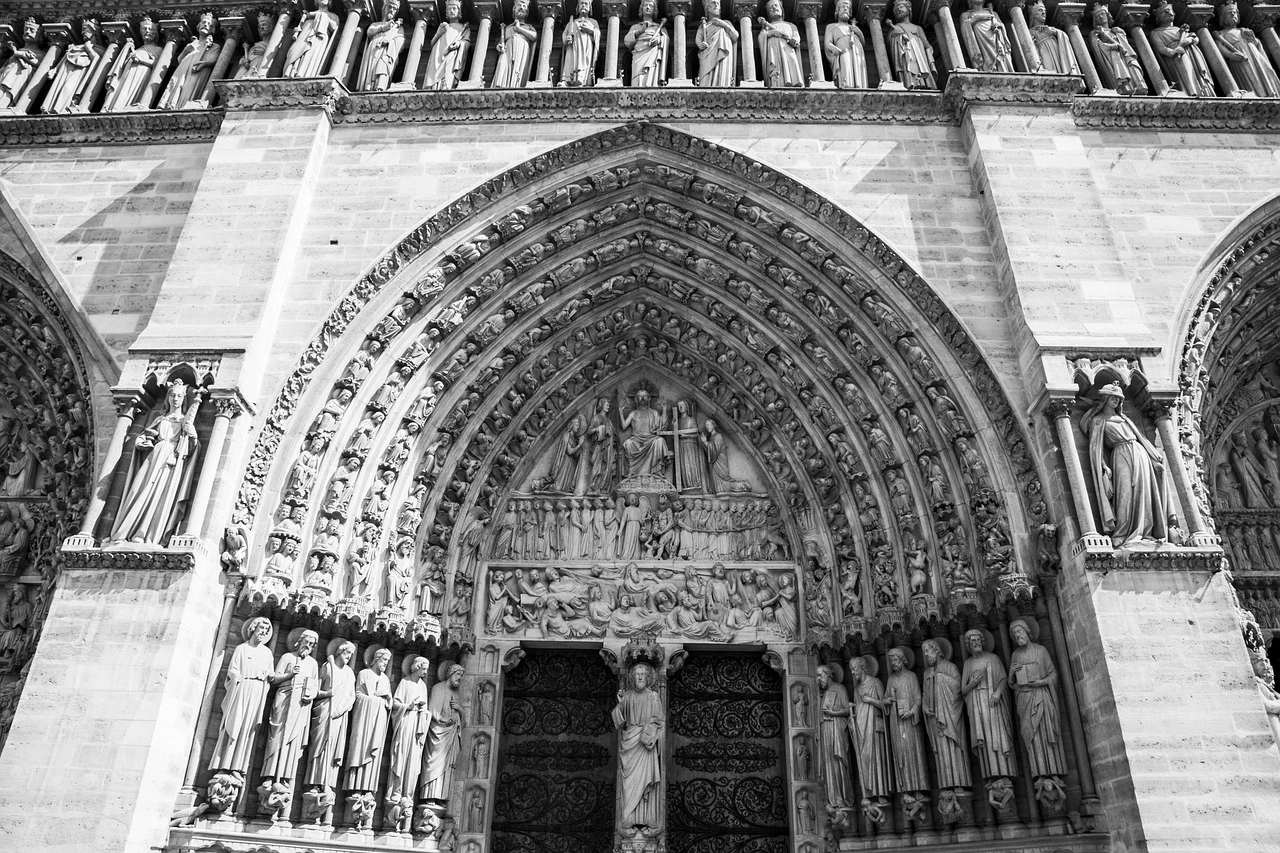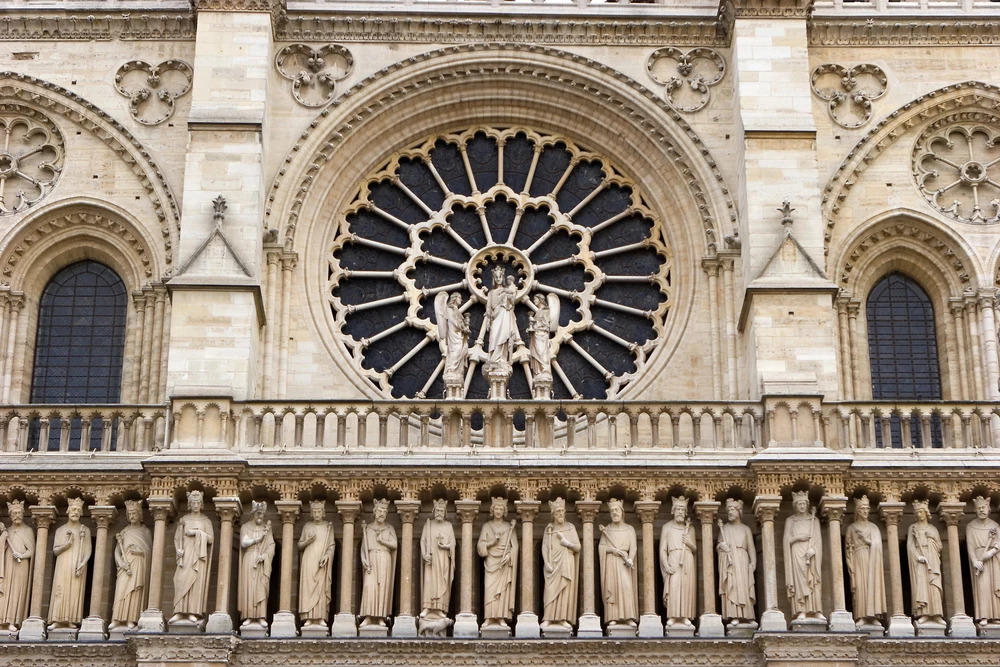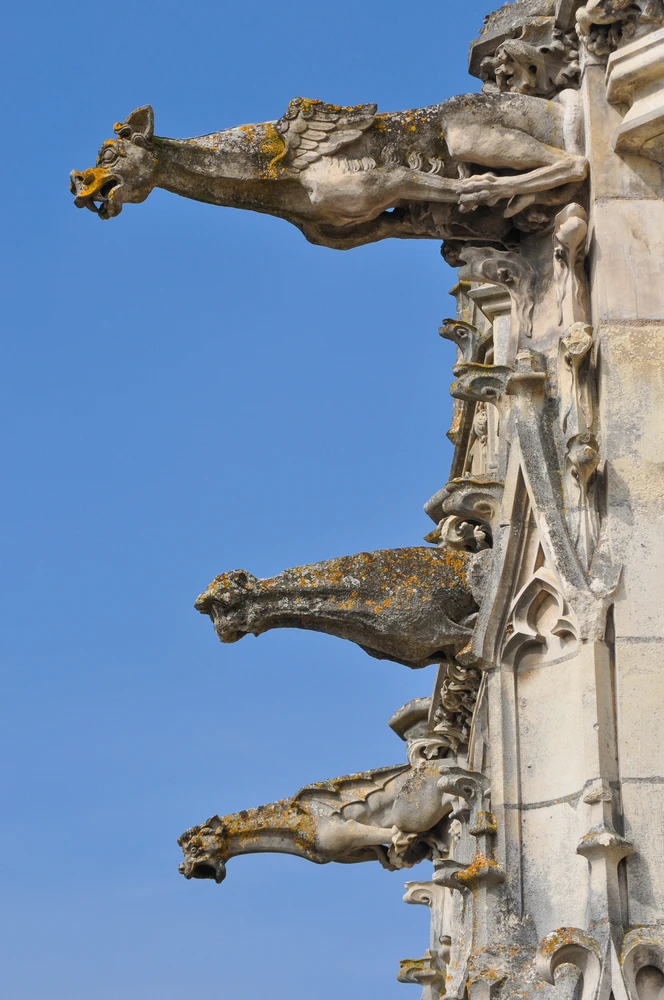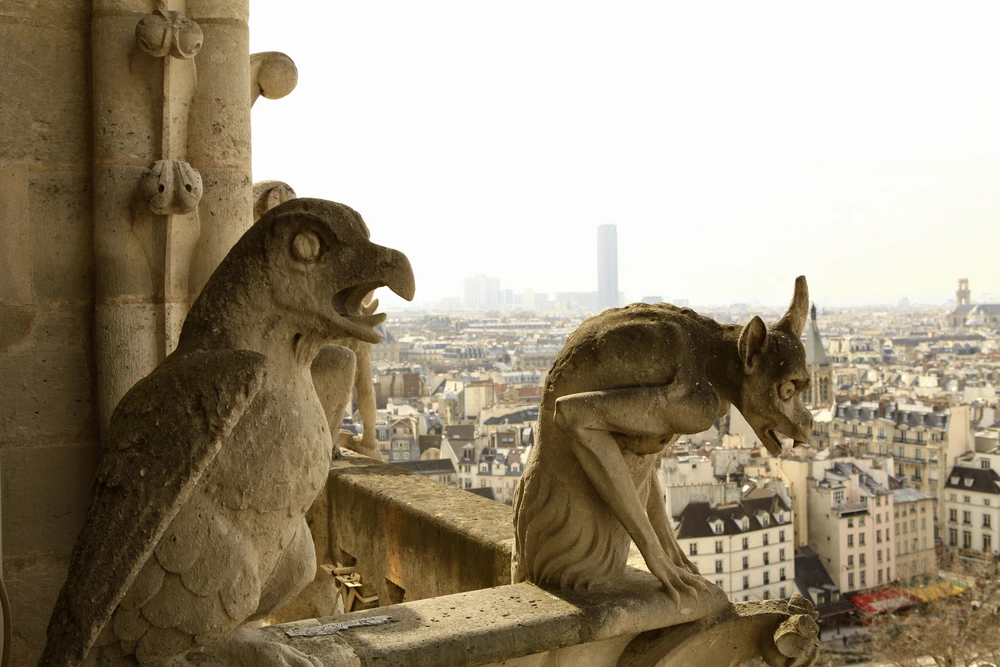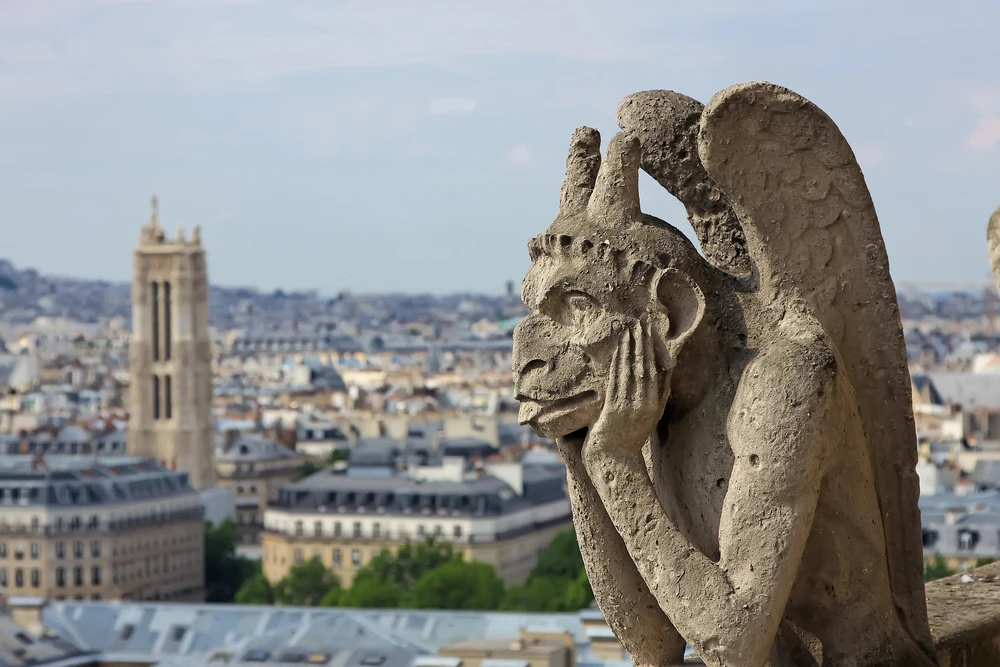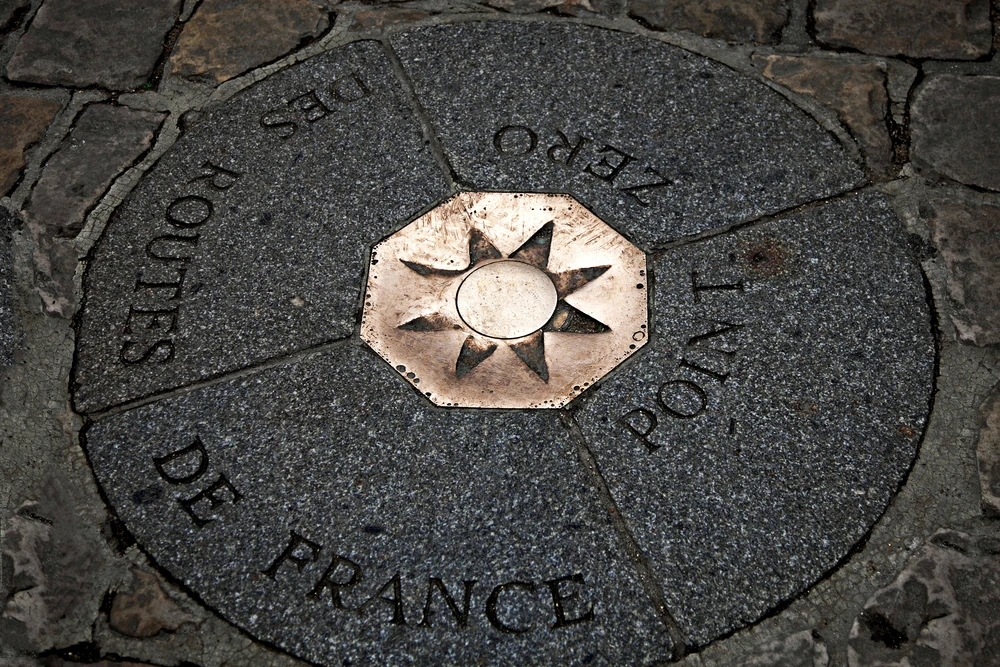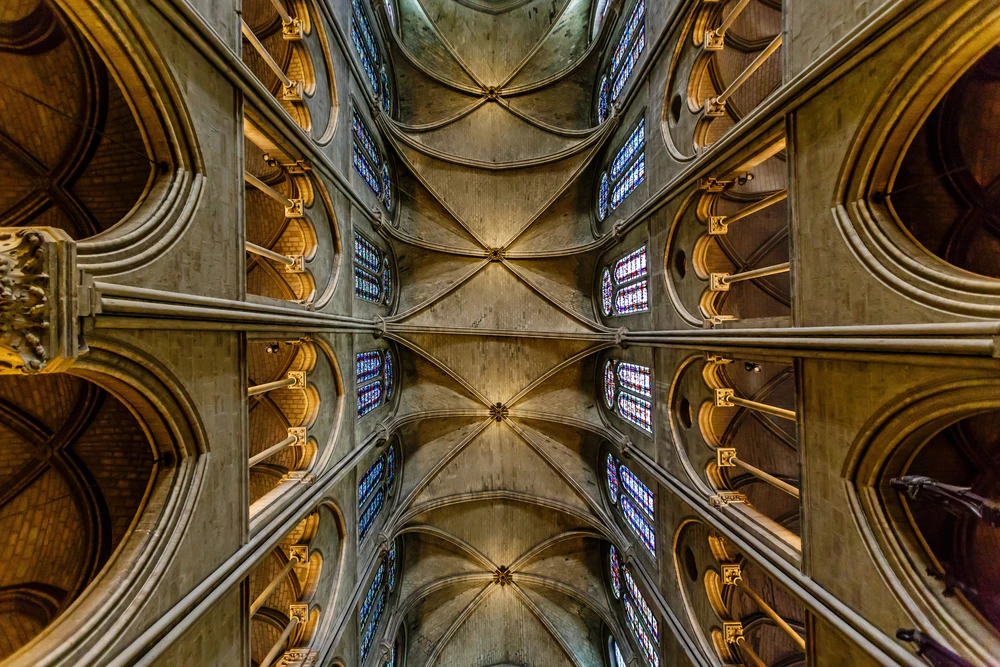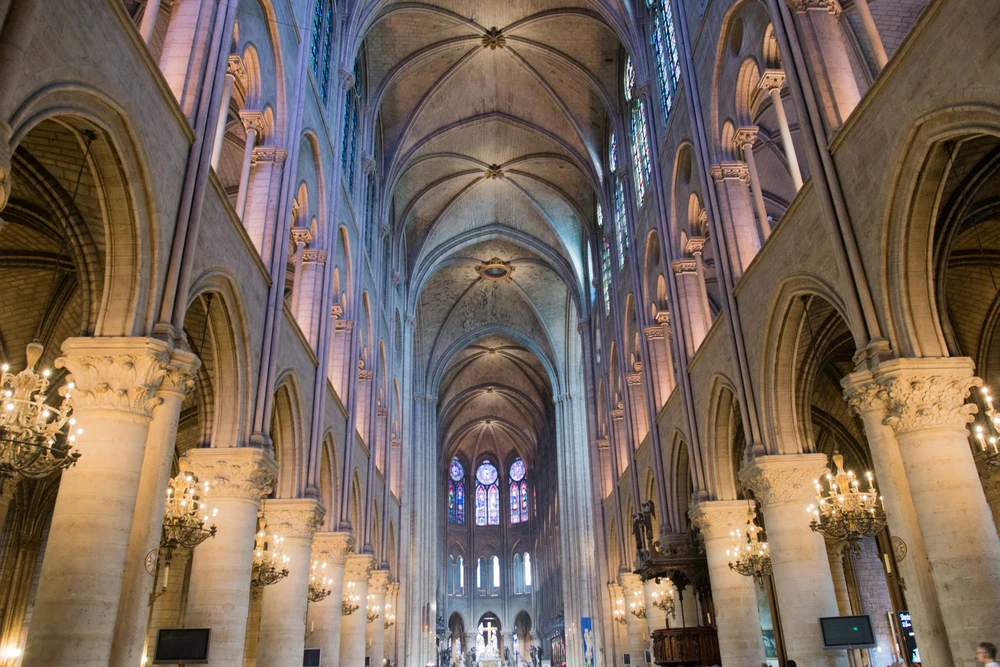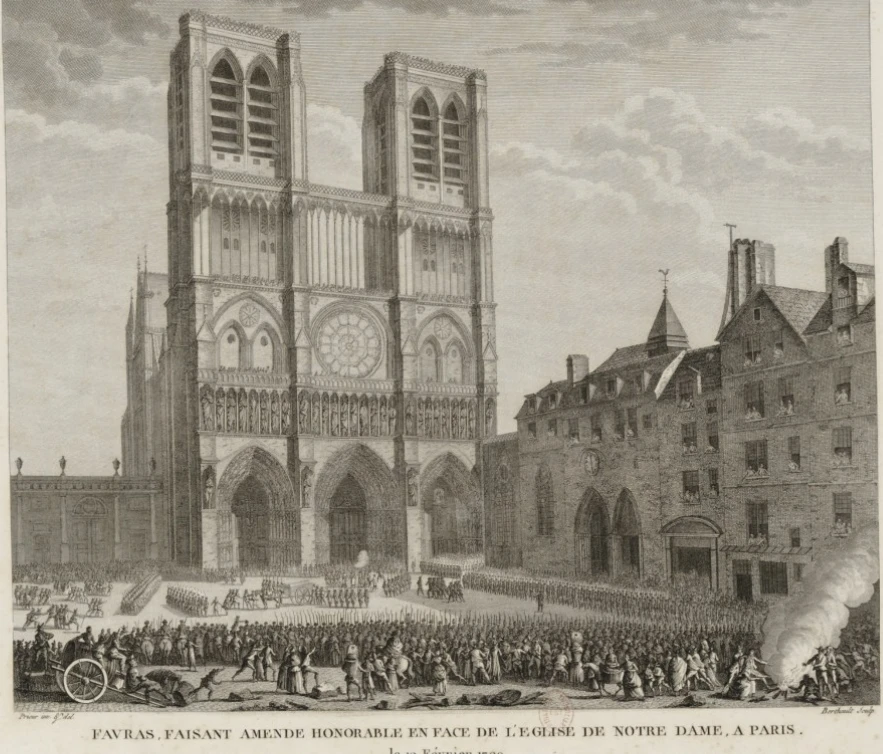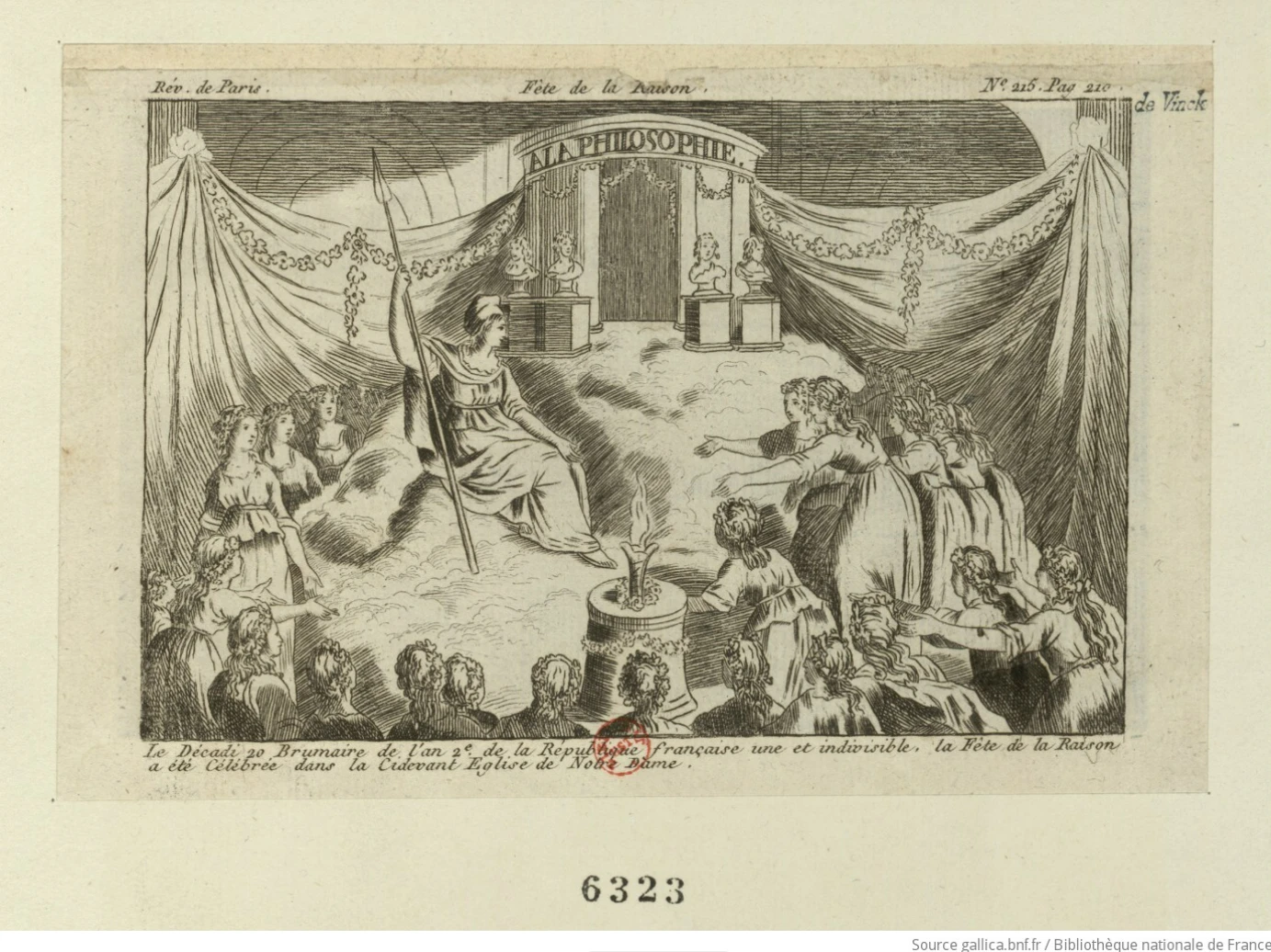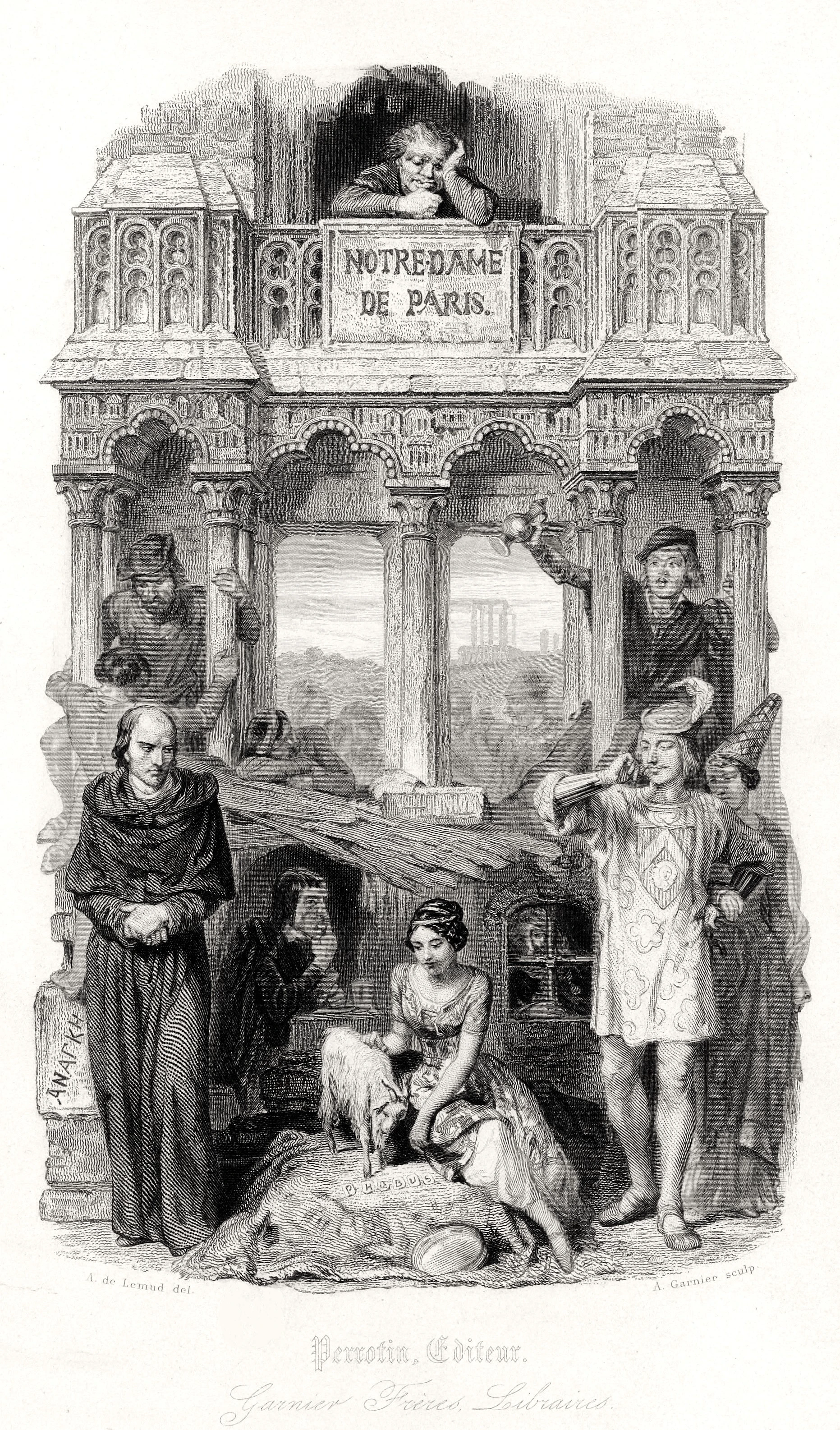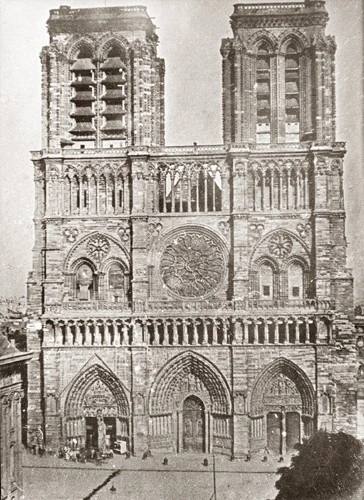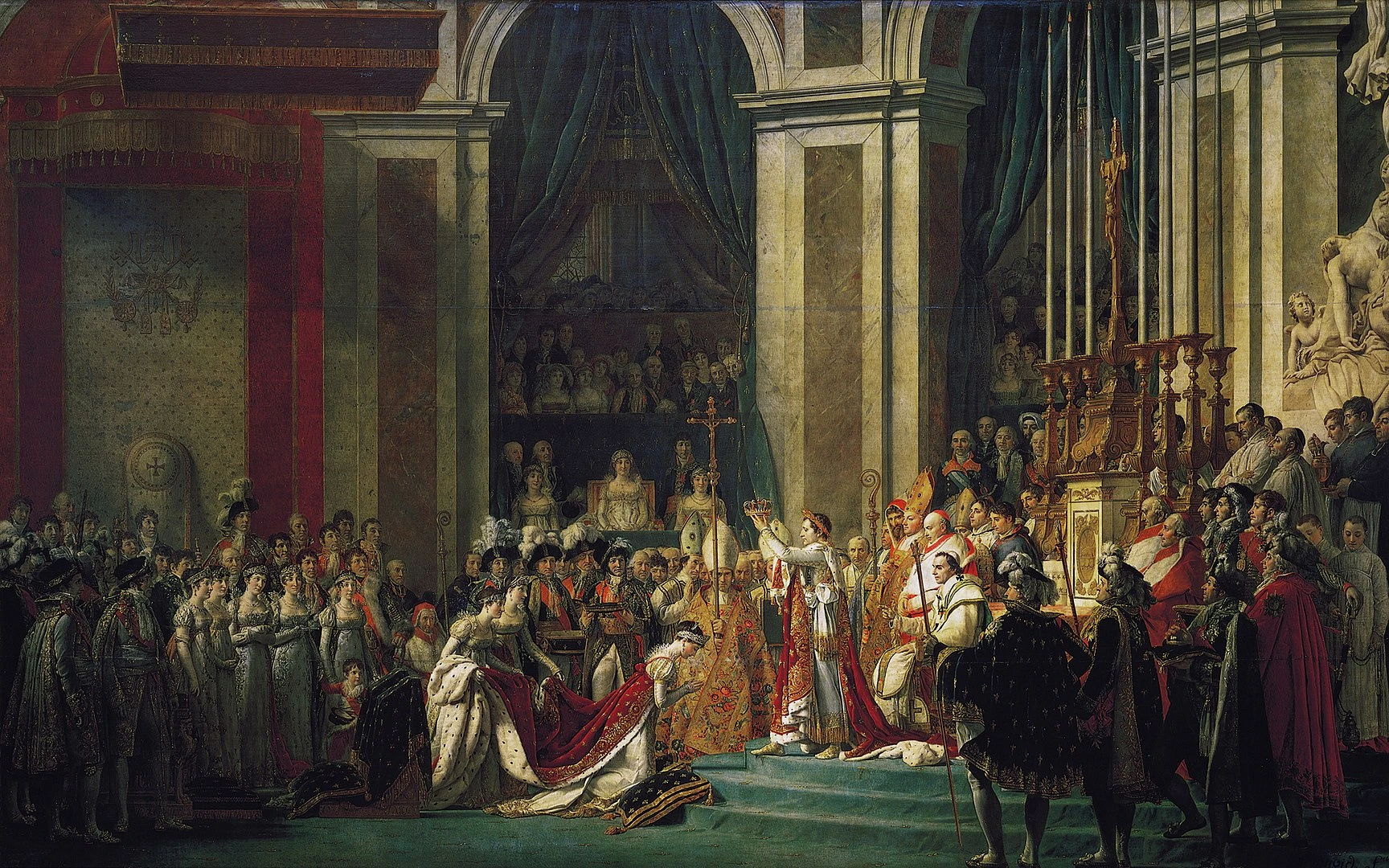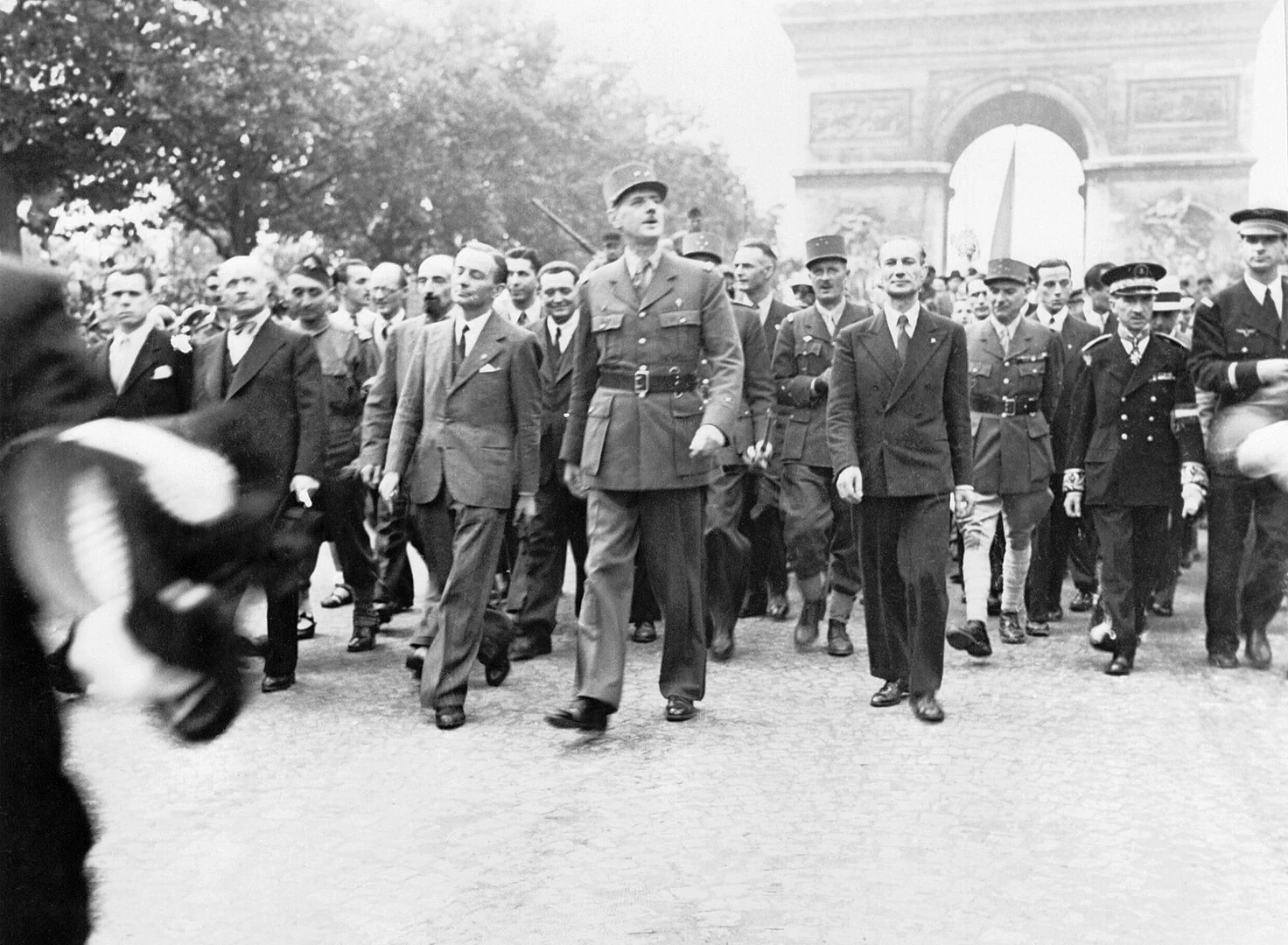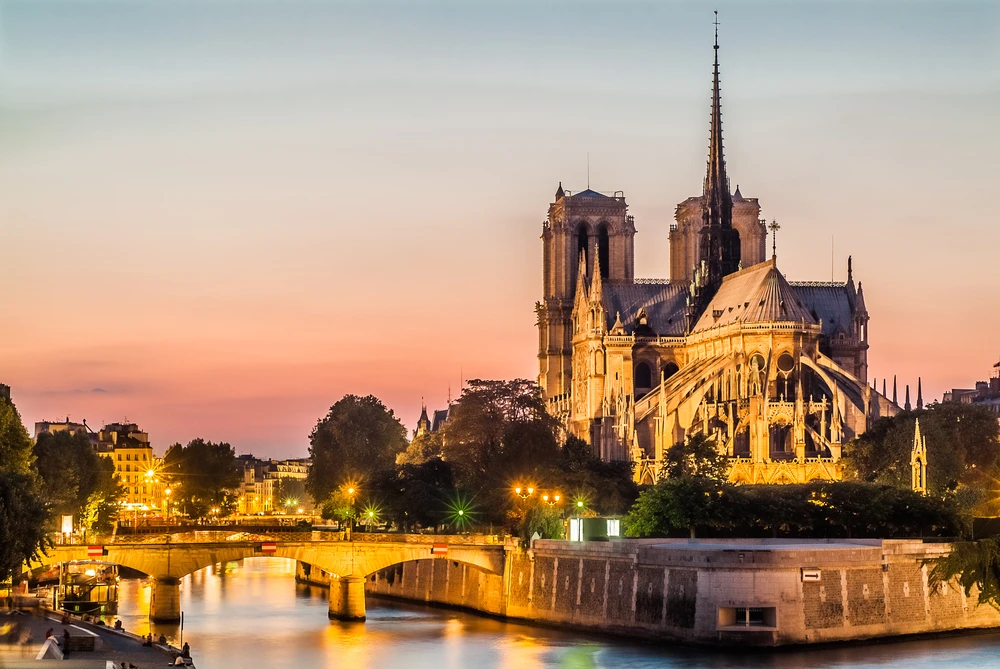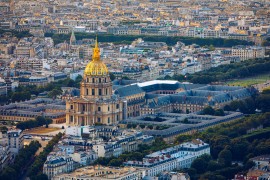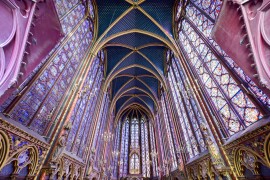Here is a summary of what you will read in the article dedicated to Notre-Dame Cathedral in Paris.
It reviews key historical moments, from its medieval construction to the 2019 fire.
You will also discover its architecture, its symbolic meaning, and its artistic heritage.
The article provides visiting hours, access information, and practical tips.
It also explains current opening conditions and the state of the restoration works.
Notre Dame de Paris in figures
Notre Dame emerging from the Île de la Cité in the heart of Paris. Photo selected by Monsieur de France: olgacov via depositphotos
Length, width, surface area of Notre Dame: impressive figures.
Notre-Dame de Paris is 127 metres long and 48 metres wide. It is also 69 metres high for the two towers and 69 metres at the top of the spire, which is its highest point. With a surface area of 5,500 square metres, it has 1,000 square metres of stained glass windows, 29 chapels and can accommodate up to 7,000 people, or even 9,000 if the galleries are included.
Notre Dame Cathedral in Paris is not the largest cathedral in France. Notre Dame Cathedral in Amiens is twice its size. Nor is it the tallest cathedral in France; that honour goes to Rouen Cathedral, which stands at 151 metres. However, it is the most famous and most visited cathedral in the world. Photo chosen by Monsieur de France: by LoneWombatMedia from Pixabay.
For the roof, the medieval framework, which burned down in 2019, consisted of around 2,500 beams, most of them made of oak. They have all been rebuilt according to best practice and the trees were sourced (sometimes donated) from forests across France to recreate what was known as "the forest", such was the number of trunks required. The spire was also rebuilt based on the model left in the 19th century by architect Viollet le Duc. It is made up of 500 tonnes of wood and 250 tonnes of lead. The statues surrounding it, representing the 12 apostles, are the original statues; they were not destroyed by the fire.
170 years to build the essentials. Several centuries to complete the work.
One of the oldest representations of Notre Dame: the descent of the Holy Spirit by Jean Fouquet in 1450, 100 years after the completion of the towers. Source: Monsieur de France: Wikipedia/Wikimedia Commons.
The first stone of Notre Dame Cathedral in Paris was laid in 1163 at the behest of Bishop Maurice de Sully (c. 1105–1196). It is the fourth Christian building on this site, as an early church existed here in the 4th century, followed by a Merovingian basilica, which was replaced by a Carolingian cathedral and then a Romanesque cathedral, which quickly proved insufficient for Paris, which had become the capital of the kings of France. A brand new Gothic-style cathedral was therefore built, starting in 1163. Work began on the choir and the ambulatory (the rear of the cathedral) and ended with the structural work, completing the South Tower in 1240 and the North Tower in 1250 (and the decision was made not to crown it with a spire, as this would have been too expensive and unstable). The Romanesque portal was destroyed and subsequently replaced. The flying buttresses were completed in 1363 and support the walls. Work on the interior continued for several more centuries. Buildings were added around it, notably the cloister and the episcopal palace. They have since disappeared. Numerous modifications were made, particularly in the 19th century when Notre Dame had to be saved and the architect Viollet le Duc added a few elements such as the famous spires and the gargoyles and chimeras that have become iconic features of the monument. The famous stryge is the most well-known.
The famous stryge, added in the 19th century, looks as though it has always been here. Photo chosen by Monsieur de France: aurelie_rosman via depositphotos
Notre Dame: the cathedral of records
Notre Dame was long the tallest monument in Paris, before Les Invalides dethroned it during the reign of Louis XIV in the 17th century. Before COVID and its closure due to fire, it was one of the most visited monuments on the planet and the most visited monument in France and Europe, with between 13 and 14 million tourists per year.
Notre Dame Cathedral in Paris is one of the most visited monuments in the world. Photo selected by monsieurdefrance.com: mac_sim via depositphotos
Notre Dame Cathedral from the outside
Notre Dame emerges from a forest of bell towers in the Middle Ages, as shown in this illumination by Jean Froissard from around 1475. Image selected by monsieurdefrance.Com: BNF / Bibliothèque Nationale de France.
Since Baron Haussmann's work, which remodelled Paris in the 19th century and literally transformed the Île de la Cité on which Notre Dame is located, its forecourt has been visible from afar. This was not at all the case in the past. The cathedral was surrounded by houses of varying heights and a maze of streets and alleys. You could only see it when you were standing in front of it.
The façade and towers of Notre Dame
When we enter Notre Dame. Photo selected by Monsieur de France: gilmanshin via depositphotos
The two towers were completed in 1240 for the south tower (on the right) and in 1250 for the north tower (on the left). They are each 69 metres high and you have to climb 422 steps to reach the top. They were originally supposed to be topped with a spire. They contain 21 bells, each with its own name, and they date from 2013, as the old bells were replaced except for one: the oldest, a bourdon bell named Emmanuel. Its godfather is Louis XIV, and it rang for the first time in 1683. The bourdon of Notre Dame is one of the largest bells in Europe, with a diameter of 2.61 metres and weighing 13 tonnes, including 500 kg for the clapper alone.
The eardrums
The central tympanum depicting the Last Judgement, with Christ in Majesty at the centre and the 12 apostles on either side of the two doors. Photo selected by monsieurdefrance.com: by Ichigo121212 from Pixabay
The entrance has three large doors, each topped with a sculpted tympanum. The tympanum of the north tower (on the left) is dedicated to the Virgin Mary, while the tympanum of the south tower (on the right) is dedicated to Saint Anne, the grandmother of Jesus. In the centre, the tympanum of the central portal is called the Last Judgement tympanum. In the centre is Jesus, seated in majesty. Below him is the Archangel Saint Michael, who weighs souls and decides who will go to hell or who will remain with Christ. On either side, we see all of humanity, including the rich, the poor, kings and even a pope. Between the two doors of the central portal, Jesus teaches, and on each of the two doors, we can see the 12 apostles.
The Gallery of Kings at Notre Dame
The gallery of kings at Notre Dame Cathedral in Paris. Photo selected by Monsieurdefrance.Com: Birute via depositphotos
It literally crosses the façade of the cathedral and there are 28 crowned kings representing the 28 generations of kings of Judea. Originally, the statues, each measuring just over 3.5 metres, were painted in bright colours. All the heads were cut off during the French Revolution. Some of them are now in the Cluny Museum. They were replaced in the 19th century during renovation work by Eugène Viollet-le-Duc, the famous architect. Above, the Virgin Mary is surrounded by two angels symbolising sin and redemption. Behind her is a 9.6-metre rose window.
Gargoyles and chimeras of Notre Dame
Gargoyles of Notre Dame Cathedral in Paris. Photo selected by monsieurdefrance.com: scrisman via depositphotos
They are very famous. Some date back to the Middle Ages, but most were created during the renovation of the 1860s. Originally, gargoyles were used to drain water and prevent it from stagnating on the edges of roofs. Those on the flying buttresses date back to the Middle Ages (around 1225). They are often made in the shape of fantastical and frightening animals.
Chimeras of Notre Dame Cathedral in Paris. Photo selected by monsieurdefrance.com: fotomem via depositphotos
Chimeras are statues that have no technical purpose but serve to adorn certain parts of the facades, particularly the balconies of the towers. They were the brainchild of Viollet-le-Duc and 19th-century stonemasons. They are often burlesque, inspired by fantastical animals or humans. The best known is the stryge, which seems bored as it contemplates Paris with its head resting on one hand.
The stryge, the most famous of the chimeras born in the 19th century, but which seem to have come straight from the Middle Ages. Photo chosen by Monsieur de France: sborisov via depositphotos
On the forecourt of Notre Dame: ground zero
It is from this famous zero point located on the forecourt of Notre Dame that all distances in France are calculated. Photo selected by monsieurdefrance.com: johan10 via depositphotos
In 1924, a plaque was installed on the forecourt of Notre Dame Cathedral. All distances to and from Paris are calculated from this plaque. For other distances indicated on road signs between two municipalities, these distances are calculated from the town hall.
Inside Notre Dame Cathedral in Paris
The interior of Notre Dame Cathedral. Photo selected by Monsieur de France: anshar via depositphotos.
What you can discover while walking around Notre Dame
What we will discover is a completely cleaned and white cathedral. After the fire in 2019, the interior was completely cleaned and restored. Centuries of burning candles and human breath, as well as air pollution, had significantly blackened the interior of Notre Dame. The nave is 13 metres wide, 60 metres long and 33 metres high.
The nave of Notre Dame Cathedral in Paris. Photo selected by Monsieur de France: izanbar via depositphotos
The choir, where the high altar is located, features a Pietà (Mary at the foot of the cross). It is surrounded by two railings. The north fence, on the right, is the oldest, dating from the 13th century, and depicts moments in the life of Christ from his birth onwards. The ambulatory allows visitors to walk around the building, which has 29 chapels.
The stained glass windows of Notre Dame Cathedral in Paris
King David playing the harp. Stained glass window. Photo selected by Monsieur de France: jorisvo viadepositphotos
Notre Dame Cathedral in Paris has nearly 1,000 square metres of stained glass windows. It must be said that Gothic architecture seeks to make as much room as possible for light. Windows are therefore enlarged and walls are raised, which are then supported on the outside by flying buttresses. The stained glass windows of Notre Dame are very famous, particularly the two large rose windows that adorn the interior. They are the oldest stained glass windows in Notre Dame, dating from 1250 to 1260. The other stained glass windows from the Middle Ages were destroyed, particularly in the 18th century, and replaced with white glass, which was considered to be brighter. In the 19th century, Viollet le Duc replaced the white glass with stained glass windows that he had made in the spirit of the Middle Ages.
The south rose window dates from 1260. Photo selected by monsieurdefrance.com: gilmanshin via depositphotos
The south rose window (left) was donated by King Saint Louis in 1260. It is 13 metres in diameter. It consists of 84 panels arranged in four large circles. It depicts several saints (including Saint Denis, the first bishop of Paris) and scenes from the life of Christ, such as the resurrection of Lazarus.
The North Rose. Photo selected by monsieurdefrance.com: jcmazo69@gmail.com via depositphotos
The west rose window (on the right) is dominated by a Virgin and Child. It has three large concentric circles depicting the tribes of Israel, vices and virtues, and the twelve signs of the zodiac.
Victor Hugo and Viollet le Duc: the saviours of Notre Dame
Notre Dame de Paris in 1790 / Illustration selected by monsieurdefrance.com: Print via Gallica.fr / BNF
The storm of the French Revolution
Difficult times for Catholic worship during the French Revolution. The wave of anti-clericalism that accompanied the revolutionary events hit Notre Dame hard, as it was, of course, a symbol for a France that had suffered from the many abuses of the high clergy. In 1789, it was "placed at the disposal of the Nation," which became its owner (it had previously been owned by the Diocese of Paris). Antoine de Juigné (1728-1811), Archbishop of Paris, left the city and emigrated in 1790, seeing the turn of events. The Civil Constitution of the Clergy (1790), which secularised the property of the Church, led to the disappearance of the chapter of Notre Dame. Priests were required to swear an oath to the Constitution, and thousands refused (and went into hiding). As a result, a "swearing bishop" (who chose to swear an oath to the Constitution) was elected and installed. His name was Jean Baptiste Gobel (1727-1794). He was not the bishop of Paris, but the bishop of the Seine, the brand new department created in 1790. He could do nothing against the decrees that gradually dispersed the contents of Notre Dame. The Revolution needed money.
The Cult of Reason was established for a time at Notre Dame, replacing Catholic worship. Illustration chosen by monsieurdefrance.Com: print via Gallica.fr / BNF
Gobel ended his episcopate badly, as he was guillotined in 1794. In 1793, the cathedral was withdrawn from Catholic worship. What remained of the treasure disappeared, melted down or stolen... However, a few relics were saved, such as the Crown of Thorns. Christian and monarchical symbols were destroyed both inside and outside, as in many churches throughout France. The heads of the kings in the gallery were cut off and the statues on the portal were knocked down. On 10 November 1793, in front of a large crowd, Notre Dame was turned into the Temple of Reason. A ceremony carried a young girl in triumph within its walls. Catholic worship did not return until 1795, rather discreetly. It was returned to worship in 1802. Time and 10 years of vandalism had considerably damaged the monument, which was repaired and redecorated to host the coronation of Napoleon I in December 1804. By the middle of the 19th century, it had become so fragile that it was in danger of collapse...
Victor Hugo and the Hunchback of Notre Dame
When he published his novel Notre Dame de Paris and introduced Esmeralda and Quasimodo to the world's imagination, Victor Hugo also brought the magnificent monument to the fore at a time when the funds for the first restoration project had been exhausted and much work remained to be done to renovate the site. The statues destroyed during the Revolution had not yet been replaced, many stones were missing, numerous pinnacles had fallen, and others were in danger of falling. The success of the novel and a growing awareness among Parisians and the State placed Notre Dame at the centre of a huge renovation project that would save it but also change it. The novel has followed its own destiny since its publication in 1832. It is known throughout the world and has also been adapted for the theatre, cinema, cartoons and even musicals - one of the greatest musicals in French history is called Notre Dame de Paris.
The first page of an 1844 edition of "Notre Dame de Paris". Illustration selected by monsieurdefrance.com: Aimé de Lemud, Public domain, via Wikimedia Commons
Lassus and Viollet le Duc: the rebirth and transformation of Notre Dame Cathedral in Paris.
During a project lasting several years, architects Jean Baptiste Antoine Lassus (1807–1857) and Eugène Viollet-le-Duc (1814–1879) undertook the renovation of Notre Dame Cathedral in Paris. It was high time, as the building was so badly damaged that for a while its demolition was considered. The word "renovation" should not be understood in the modern sense, at a time when the aim is to restore a building as closely as possible to its original state. The architects repaired the building, of course, but they also transformed it. The medieval spire, destroyed in the 18th century, was replaced by a much larger one, rising to a height of 96 metres (and surrounded by the 12 apostles, one of whom bears the likeness of Viollet-le-Duc).
Notre Dame in an 1840 daguerreotype that clearly shows its state of disrepair. The gallery of kings is still empty of statues. Illustration chosen by monsieurdefrance.com: By Noël Paymal Lerebours — http://www.luminous-lint.com/app/image/2195803712147396029963586417/, Public domain, https://commons.wikimedia.org/w/index.php?curid=15461275
Chimeras, fantastical creatures, were added (particularly to the towers) and became iconic features of Notre Dame. The clear stained glass windows of the 18th century were replaced by colourful stained glass windows. The interior was sometimes painted. The furnishings were created from scratch, as nothing remained. Viollet-le-Duc, who took over the project after Lassus's death, wanted to recreate the Middle Ages as he imagined it. His work, sometimes controversial, has stood the test of time and, even though the question arose at the time of the 2019 fire, it has been integrated into the building to such an extent that the spire that was destroyed has been replaced by an identical spire, created by the craftsmen using the plans left by the architect.
4 events that Notre Dame has experienced
1239 Saint Louis places the crown of thorns there
While undertaking the construction of the Sainte Chapelle nearby to house the Holy Crown, Saint Louis placed the relic in Notre Dame. It remained there for several years before being installed in the completed Sainte Chapelle. It returned to Notre Dame in 1806 and has remained there ever since. It is displayed and venerated by the faithful during Holy Week. It is part of the treasure of Notre Dame, alongside several other relics such as the nail and wood from the Cross and the shirt of Saint Louis. In the Middle Ages, Notre Dame witnessed the disappearance of the Knights Templar (their leaders were burned alive not far from Notre Dame, which they could see from their pyre). It saw the English settle in Paris for much of the Hundred Years' War before being driven out of the capital. It was at Notre Dame that the trial for the rehabilitation of Joan of Arc was held in 1453.
18 August 1572: the beginnings of the St Bartholomew's Day massacre
Queen Catherine standing before piles of corpses at the exit of the Louvre. Illustration chosen by Monsieur de France: By François Dubois, Édouard Debat-Ponsan, Public domain, via Wikimedia Commons
On 18 August 1572, Catherine de Medici, Queen Mother, and her son King Charles IX attempted once again to reconcile Catholics and Protestants through marriage. The idea was to unite the two religions, which were often at war with each other, by marrying Marguerite de Valois (1553-1615), better known as "Queen Margot", a Catholic, to Henri de Navarre (1552-1610), a Protestant prince. Tension was at its peak, with the marriage being morally condemned by the staunchly Catholic Parisians, while many Protestants had come to attend the royal wedding. The wedding took place on a platform in front of Notre Dame. A few days later, the bells of the churches of Paris, including Notre Dame, ring out the alarm and the massacre of Protestants begins on St. Bartholomew's Day. After the death of Coligny, the Protestant leader assassinated by the Duke of Guise, the Catholic leader, the massacre spreads first to the Louvre and then throughout Paris. The number of victims in Paris is estimated at 3,000 men, women and children. The massacre also took place in several other French cities, with 10,000 people murdered.
December 1804: The Coronation of Napoleon I
On 2 December 1804, Napoleon I (1769–1821) was crowned Emperor of the French at Notre Dame, in the presence of Pope Pius VII, who had travelled from Rome to bless the new emperor. The king crowned his wife Josephine Empress. One hundred and one cannon shots were fired precisely as the Emperor left Notre Dame (which had been more or less restored for the occasion). The scene was magnificently depicted by the painter Jacques-Louis David (1748-1825) in a work created between 1805 and 1807, which can be seen at the Louvre Museum.
"The Coronation of Emperor Napoleon I" by Jacques Louis David. Illustration chosen by Monsieur de France: Public domain, https://commons.wikimedia.org/w/index.php?curid=7564091
The imperial family remained loyal to Notre Dame, with Napoleon III marrying Eugénie de Montijo there in 1853. Their son, the imperial prince, was christened there with great pomp and ceremony in 1856.
1944: the liberation of Paris.
Spared by the Commune in 1871 when Paris City Hall and the Tuileries Palace were destroyed (a fire started in the cathedral was quickly extinguished), slightly damaged by a German shell during the First World War, Notre Dame was at the heart of the fighting for the liberation of Paris in August 1944. Shots were still being fired near the Prefecture when General de Gaulle and General Leclerc entered Notre Dame to hear a magnificat after marching down the Champs-Elysées. The bells rang out to announce the liberation of the French capital. Notre Dame is closely linked to the major events that Paris experiences. Happy ones, such as the Liberation, or very sad ones, such as when it tolled for 15 minutes on 15 November 2015 in memory of the victims of the attacks of 13 November (Le Bataclan, the Stade de France, etc.).
General de Gaulle walks down the Champs-Élysées towards Notre Dame to celebrate the Liberation of Paris. Image selected by monsieurdefrance.com: By unknown author — http://media.iwm.org.uk/iwm/mediaLib//7/media-7068/large.jpgThis photograph HU 66477 comes from the collections of the Imperial War Museums. Public domain, https://commons.wikimedia.org/w/index.php?curid=25092775
2019 the great fire
On 15 April 2019, as renovation work on the spire began and scaffolding was erected, a fire broke out inside the 800-year-old roof structure and spread rapidly. By evening, after 15 hours of firefighting and a relentless battle by the Paris fire brigade, the spire and roofs were completely destroyed. The interior of the building was also affected, particularly the choir. But Notre Dame is still standing, and a huge outpouring of national and global solidarity has made it possible to finance and launch the reconstruction project a few months later, with the aim of opening the cathedral in time for the Olympic Games five years later, in 2024. The building is once again covered and visible without scaffolding, and the spire is back in the Paris sky for the 2024 Paris Olympic Games. The interior is scheduled to open on 7 December 2024.
Why Notre-Dame de Paris is so important to the French
For the French, Notre-Dame de Paris is not just a cathedral: it is a beating heart, that of their history and identity. Built in the 12th century, it has witnessed kings and revolutions, prayers and flags, pain and rebirth. It was here that Napoleon's coronation, the funerals of presidents and the great moments of an entire people were celebrated. Its silhouette has watched over Paris for nearly nine centuries, like a benevolent mother who has seen everything. When its flames lit up the night sky in April 2019, the whole of France wept, believers and non-believers alike, aware that they were losing a shared symbol. For Notre-Dame represents faith, of course, but also beauty, literature, the genius of its builders and the memory of those who have always gathered in its shadow. It embodies the soul of France, that fragile alliance between grandeur and emotion.
Notre Dame Cathedral: practical information
Notre Dame at sunset. Image selected by Monsieurdefrance.Com: STYLEPICS via depositphotos.
Opening hours of Notre Dame de Paris
Monday to Friday 7:50 a.m. to 7 p.m. until 10 p.m. on Thursdays
Saturday and Sunday
8:15 a.m. – 7:30 p.m.
Last admission 30 minutes before closing time
GPS address of Notre Dame Cathedral in Paris
Place Jean Paul II, 75 004 PARIS.
Nearest car park: Indigo Lutèce, Boulevard du Palais (reservation required) and Indigo Hôtel de Ville, 48 Rue de l'Hôtel de Ville.
Prices for Notre Dame de Paris
It's free! Access to Notre Dame is free.
Do not purchase tickets.
BOOK A VISIT: https://www.notredamedeparis.fr/
Metro
Line 4: Cité station or Saint Michel station
Line 1; Town Hall station
Line 7, line 11
RER B and C Saint Michel Notre Dame station
There will be
Lines: 87 / 47 / 75
Frequently asked questions about Notre-Dame Cathedral in Paris
When was Notre-Dame Cathedral built?
Construction of Notre-Dame Cathedral began in 1163 during the reign of Louis VII and was completed in the 14th century, after nearly two centuries of work.
Why is Notre Dame Cathedral so famous? It is famous for its iconic Gothic architecture, its stained glass windows, its gargoyles, and its central role in French history, notably the coronation of Napoleon I and Victor Hugo's novel.
Can we visit Notre-Dame Cathedral in Paris today?
Following the fire on 15 April 2019, the cathedral is currently undergoing restoration work. It is scheduled to reopen to the public in December 2024, but visitors can already visit the forecourt and admire the exterior.
What was lost in the 2019 fire?
The roof, Viollet-le-Duc's spire and part of the medieval framework, nicknamed "the forest", were destroyed. Fortunately, the façade, the towers and most of the stained glass windows were saved.
Where is Notre-Dame Cathedral located?
It is located on the Île de la Cité, in the heart of Paris (4th arrondissement), easily accessible from the Cité or Saint-Michel – Notre-Dame metro stations.
What treasures does Notre-Dame hold?
Among the most precious are the Crown of Thorns of Christ, a fragment of the True Cross, and one of the nails of the Crucifixion, kept in the cathedral's treasury.
Who rebuilt the spire of Notre Dame?
The new spire was faithfully reconstructed according to Viollet-le-Duc's plans, using the same materials and traditional techniques.
How many people visit Notre-Dame each year?
Before the fire, the cathedral attracted nearly 13 million visitors per year, making it the most visited monument in Europe.
What role did Victor Hugo play in Notre Dame's fame?
Victor Hugo's novel Notre Dame de Paris (1831) played a major role in saving the building, which was then threatened with destruction, by reviving public interest in medieval heritage.
Is there a museum dedicated to Notre-Dame?
Yes, the Archaeological Crypt of the Île de la Cité, located beneath the forecourt, presents the history of the site since ancient times and currently hosts exhibitions dedicated to the restoration of the cathedral.
time datetime="30 October 2025">Updated: October 2025</time>

